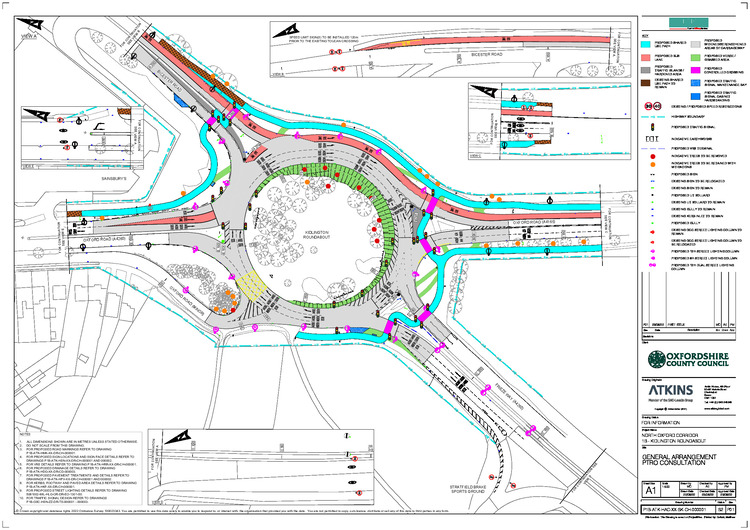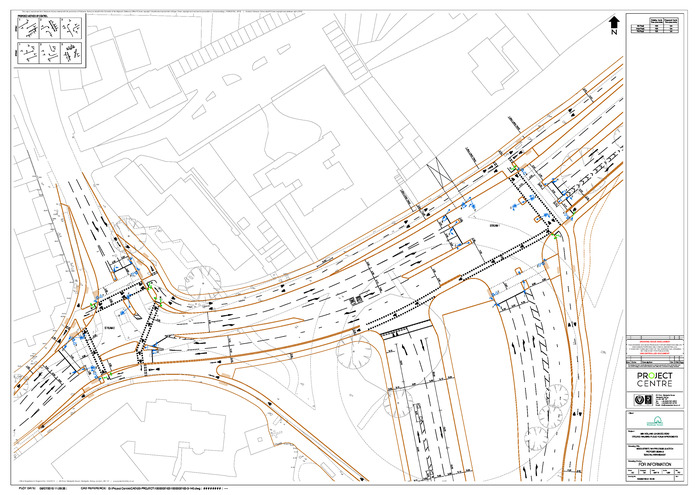The plans for redesigning the roundabout south of Kidlington are inconsistent with both the county's headline car-trip reduction targets, its active travel goals, and its Vision Zero commitment.
Update: the design was completely reworked in 2023, and the resulting roundabout is one of Oxfordshire's active travel success stories.
The new design is clearly aimed at fitting more cars through than the current layout. It has three lanes marked around most of the roundabout where the current layout (without marked lanes) really only supports two. The primary design goal was clearly to optimise motor traffic flows, and as such will encourage people to drive and induce more car trips.
Turning to active travel. Some walking and cycling movements will require four signalled stages (possibly six, since there appears to be no crossing of Oxford Rd north), which could conceivably take eight minutes depending on the signal timings. (We don’t know exactly what these will be, but given practice elsewhere they will undoubtedly prioritise motor traffic flow.) This is a huge barrier to active travel, as can be seen with the Wolvercote roundabout.
Other concerns include the use of two-way shared use paths. These are much better than the existing paths, but need to be designed for significantly higher volumes of both foot and cycle traffic in ten years, once the planned housing developments go in; there also needs to be a plan for huge peak pedestrian flows at event times if the relocation of the football stadium to Stratfield Brake goes ahead.
A consequence of long delays are that 1) some people will choose to cycle with the motor traffic instead of using the crossings and 2) other people, both walking and cycling, will jump red lights to speed up crossing. Again, the Wolvercote roundabout provides examples of this, though pretty much any junction in Oxford with multi-stage crossings or long delays (say the Iffley-Donnington Bridge junction, or the junction of Beaumont St and St Giles) illustrates the problems for pedestrians.
While the speed limit on the roundabout and approaches is being dropped from 40mph to 30mph, nothing is being done to the layout to encourage lower speeds. This design retains the large radius and broad swept entries and exits of the current layout, which if anything are more conducive to 50mph. Especially when traffic is light, many drivers will speed through a roundabout like this, with some of them ignoring red lights if no one is visibly crossing. (See experience at the Barton Park crossing and elsewhere.)
This is a recipe for collisions, either with people cycling through the roundabout or people walking or cycling at the crossings (especially children and slower adults).
Solutions
If we need a high-throughput, high-speed roundabout of this size and scale, then there has to be grade-separation of walking and cycling.
Alternatively, we could have a much more compact roundabout, with one-lane entries and exits (plus the bus lane) and sharp corners encouraging lower speeds. Walking and cycling crossings could either be signalled and single-stage on each arm, or could be two-stage but unsignalled (as at present, but better designed).
Another option (suggested by Richard Mann) would be to have two small roundabouts instead of one giant one, both along Dutch lines - so unsignalled but (as peri-urban) with car priority rather than cycle priority.
Two signalled t-junctions would also be a possibility, wth the Whipps Cross junction in Waltham Forest a possible model. Originally a giant roundabout, this was redesigned as a set of T-junctions. While this has a lot of lanes for cars, it has signalled single-stage pedestrian and cycle crossings of each arm.
Twitter threads:



I think this roundabout requires the Dornbirn/Stevenage treatment i.e. complete grade segregation for active travel (there is room).
I would punch a box tunnel under the road from Bicester.
At the Oxford parkway junction do the same thing. Decide also which side the active travel should be on. Just support one side and make it completely grade separated so cyclists and pedestrians never meet a motor vehicle.
Brian's idea seems plausible to me. Underpasses at Oxford Parkway (both of the entry road and the Oxford Rd), then a two-way cycle track on one side of Oxford Rd heading north, a cantilevered track next to the bridge over the railway, then underpasses to connect that track to the other arms of the roundabout.
If the football ground moves to Stratfield Brake we'll need infrastructure designed to get a lot of pedestrians there from the railway station.